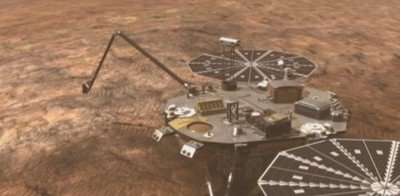Has A Longer Trip Scheduled For August
 NASA's Phoenix Mars Lander
took a little trip Monday, crossing the US from Colorado to
Florida's Kennedy Space Center onboard a USAF C-17 cargo plane. The
probe will undertake a much longer journey in August, when NASA is
scheduled to send the oft-delayed spacecraft to the Red Planet.
NASA's Phoenix Mars Lander
took a little trip Monday, crossing the US from Colorado to
Florida's Kennedy Space Center onboard a USAF C-17 cargo plane. The
probe will undertake a much longer journey in August, when NASA is
scheduled to send the oft-delayed spacecraft to the Red Planet.
After launch, Phoenix will land on a Martian arctic plain next
spring. It will use a robotic digging arm and other instruments to
determine whether the soil environment just beneath the surface
could have been a favorable habitat for microbial life. Studies
from orbit suggest that within arm's reach of the surface, the soil
holds frozen water.
"This is a critical milestone for our mission," said Peter Smith
of the University of Arizona, Tucson, principal investigator for
Phoenix. "Our expert engineering team has completed assembly and
testing of the spacecraft. The testing shows our instruments are
capable of meeting the high-level requirements for the
mission."
Workers have been assembling and testing the spacecraft for more
than a year in Denver. "We're excited to be going back to Mars,"
said Ed Sedivy, Phoenix program manager at Lockheed Martin Space
Systems in Denver. "Assembly, integration and testing of the
spacecraft have gone very well. We delivered Phoenix stowed inside
its back shell and it will stay in that configuration until it
lands softly on Mars."
A Delta II launch vehicle will start Phoenix on its longer trip
from Cape Canaveral Air Force Station, FL. The earliest possible
launch time will be August 3, at 5:35 am EDT. Opportunities for
energy-efficient launches to Mars come about every two years.
Orbital geometries of Mars and Earth make this year particularly
favorable for sending a lander to far-northern Mars to arrive when
sunshine is at a maximum there.
"The arctic plains are the right place for the next step in Mars
exploration, and this is the right time to go there," said Leslie
Tamppari, Phoenix project scientist at NASA's Jet Propulsion
Laboratory, Pasadena, Calif. "We expect to touch Martian ice for
the first time, a real leap in NASA's follow-the-water strategy.
The lander needs solar energy, and we will arrive for a three-month
prime mission right at the end of northern Mars' spring."
Phoenix will be prepared for launch in a payload processing
facility at NASA's Kennedy Space Center, FL. The first checkout
activity will be a spin-balance test May 10 and 11. This will be
followed on May 15 by installation of the heat shield and then a
separation test. The next major milestones, during the third week
of May, will be a landing radar integration test and launch system
verification test. The last week of May will include an entry,
descent and landing system verification test, followed by a
guidance navigation and control test.

The rocket poised to launch Phoenix is a Delta II 7925,
manufactured by United Launch Alliance, Denver. The first stage is
scheduled to be hoisted into the launcher of Pad 17-A at Cape
Canaveral Air Force Station the third week of June. Nine strap-on
solid rocket boosters will then be raised and attached. The second
stage, which burns hypergolic propellants, will be hoisted atop the
first stage the first week of July. The fairing, which surrounds
the spacecraft, will then be hoisted into the clean room of the
mobile service tower.
Next, engineers will perform several tests of the Delta II. In
mid-July, as a leak check, the first stage will be loaded with
liquid oxygen during a simulated countdown. The next day, a
simulated flight test will be performed, simulating the
vehicle’s post-liftoff flight events without fuel aboard. The
electrical and mechanical systems of the entire Delta II will be
exercised during this test. Once the Phoenix payload is placed atop
the launch vehicle in the third week of July, a major test will be
conducted: an integrated test of the Delta II and Phoenix working
together. This will be a combined minus count and plus count,
simulating all events as they will take place on launch day, but
without propellants aboard the vehicle. Finally, one week before
launch, the Delta II payload fairing will be installed around the
Phoenix lander.
The NASA Launch Services Program at the Kennedy Space Center and
the United Launch Alliance are responsible for the launch of the
Delta II.

Phoenix is the first mission of NASA's Mars Scout Program of
relatively low-cost missions to Mars. Selected in 2003, Phoenix
saves expense by using a lander structure and some other components
originally built for the 2001 Mars Surveyor mission that was
canceled while in development.
 Bolen Gives Congress a Rare Thumbs-Up
Bolen Gives Congress a Rare Thumbs-Up The SportPlane Resource Guide RETURNS!!!!
The SportPlane Resource Guide RETURNS!!!! Buying Sprees Continue: Textron eAviation Takes On Amazilia Aerospace
Buying Sprees Continue: Textron eAviation Takes On Amazilia Aerospace Hawker 4000 Bizjets Gain Nav System, Data Link STC
Hawker 4000 Bizjets Gain Nav System, Data Link STC Echodyne Gets BVLOS Waiver for AiRanger Aircraft
Echodyne Gets BVLOS Waiver for AiRanger Aircraft





